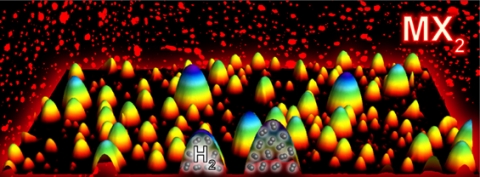Hydrogen bubbles: a novel mechanism for light generation from crystals

A recent study developed by Sapienza in collaboration with CNR and the Australian National University revealed that the formation of highly pressurized hydrogen bubbles can be exploited to modify the physical and structural properties of two-dimensional semiconducting crystals, of high interest for optoelectronics and photovoltaics. These results were published in Advanced Materials.
In the near future, the conventional, three-dimensional materials we deal with on a daily basis are going to make way for new, two-dimensional materials with exceptional properties: more robust than steel, lighter than aluminium, and as flexible as plastic. After years of flourishing research on graphene, the interest of the scientific community is increasingly shifting towards the study of alternative two-dimensional materials, capable of replacing conventional semiconductors and particularly apt for the realization of compact, energy-efficient and flexible devices.
A recent study, coordinated by researchers from the Physics Department of Sapienza (Davide Tedeschi, Elena Blundo, Marco Felici e Antonio Polimeni), in collaboration with the Research Centre for Nanotechnologies Applied to Engineering (CNIS) of Sapienza (Simona Sennato), the Institute for Photonics and Nanotechnologies of CNR (Giorgio Pettinari) and the Australian National University, has proposed a novel method to create highly mechanically-deformed two-dimensional crystals. The ability to induce controlled mechanical deformations in these materials can be exploited to achieve an on-demand tuning of their electronic, optical, and transport properties. The results of this research were published in Advanced Materials.
Two-dimensional - or 2D - semiconducting crystals have been attracting great interest due to their possible utilization for the fabrication of tuneable nanostructures and of novel electronic and optoelectronic devices. This new class of materials is characterized by a layered structure (analogous to that of graphite) that enables to isolate, via exfoliation, single layers of extremely reduced thickness (inferior to one billionth of a meter). Due to quantum effects inextricably intertwined with their two-dimensional nature, these crystals feature the ability to emit light with very high efficiency. This property, coupled to their remarkable mechanical robustness and flexibility, makes these 2D materials particularly well suited for the realization of compact and highly efficient lasers and solar cells.
The novel method presented here is based on the low-energy proton irradiation of these materials in their three-dimensional form (i.e., prior to exfoliation). Protons penetrate through the topmost layer and, once in contact with the crystalline matrix, form hydrogen molecules via the so-called hydrogen evolution reaction. This fundamental chemical reaction occurs just one millionth of a millimeter beneath the surface of the irradiated crystal, leading to the formation of hydrogen bubbles at pressures of hundreds of atmospheres and to the local blistering of just one, atomically thin, layer of the irradiated crystal. In turn, the surface of the material becomes studded with minuscule, hydrogen-filled “domes”, capable of emitting light in the infrared to visible range and at temperatures up to at least 200°C. This formation process can be carefully engineered, enabling the realization of domes with the desired dimensions and with precise ordering.
This study is characterized by a high degree of interdisciplinarity, as it involves condensed matter physics, materials science, electrochemistry, nanotechnologies, optics and mechanical engineering. The reported discoveries could have many, potentially interesting ramifications, with possible applications in the fields of photonics, nanomechanics, optomechanical actuation, sensors and green energies.
Reference
Wiley Online Library
Authors
Antonio Polimeni, Dipartimento di Fisica, antonio.polimeni![]() uniroma1.it
uniroma1.it
